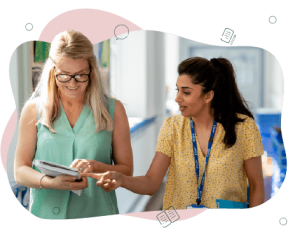27 Implementation of assessment through a play-based approach
Learning is a process and authentic assessment captures the learning as it occurs naturally.
What assessment methods can teachers use in a play-based approach?
In play-based approaches, teachers choose assessment methods and techniques to create a holistic picture of each child’s knowledge, understandings, skills and capabilities. Teachers will use a range of assessment instruments and techniques to shape their responses to children. Authentic assessment is receptive to and includes children’s views of their own learning.
Assessment and documenting learning
Documenting learning in play-based approaches can take the form of observations, portfolios, video and audio recordings, work samples, anecdotes, language transcripts, running records and student’s self-reflections. Each of these methods are detailed in the table below. It is not an exhaustive list but demonstrates the variety of tools teachers can use to identify and document learning outcomes achieved through play-based experiences.

Read, look, or listen
Diverse assessment methods and their associated purpose
Assessment method |
Description and purpose |
|---|---|
|
Note taking
|
Writing down short notes can be a very effective method of quickly keeping a record of something a child or children did, furthermore it enables things of significance not to be forgotten such as a phrase a child used, or a questioned that emerged. Notes often play an imperative part in annotating samples of children’s work or photographs of children in action (McAfee & Leong, 2011).
|
|
Anecdotal notes or records
|
The focus of an anecdotal record is on ‘how’ a child or children approached something, completed something, discussed something or problem solved. Anecdotal records are contextually focused and written retrospectively, as the teacher records their memory of a child or group of children (Martin, 2013). Anecdotal records can be thought of as a written photograph, it describes the context, who, what and where and it captures the learning of significance by drawing attention to important developmental, behavioural or cultural play and interactions. Anecdotal observations are often quite brief as they rely on the memory of the teacher (Arthur, Beecher, Death, Dockett & Farmer, 2018). |
|
Photography and videos
|
Photographs are purposeful records of samples of children’s work (for instance a microhabitat built by the children or when the children are engaged in an activity where the actions carry some of the atmosphere. For instance, when children are working together to problem solve or achieve an outcome. It is essential that the emphasis is not on the best-looking photograph but the most purposeful photograph in terms of planning, rarely of photographs of finished products have a meaningful planning purpose unless they are accompanied by summary of the process undertaken. Furthermore, photographs and videos can be shared with children to support them to reflect on their learning, creating opportunities to plan collaboratively. Photographs and videos are the accompaniments that lend themselves to future reflection and planning. |
|
Checklist
|
As a closed method of observation checklists can provide teachers with quick data about children’s development. |
|
Narratives
|
Are open methods of observation that enable the observer to use a multi-layered approach. This considers the learning, the activity, the children in the narrative, the language of the play and the context. The richness of narrative forms of observational assessment is that they lend themselves to capturing the whole picture, they are ways of entering the exploration, conversation or creative process and can be shared by a diverse audience for example, parents and children. (McLachlan, Fleer and Edwards, 2018, p.116). |
Engage and extend
Authentic assessments use a range of methods, the above table provided a brief overview of some possible methods. Consider which methods you might use in the classroom. Consider what research you have read already which would add to the evidence of purpose for different methods. Would you add another assessment method to this list and how would that method support you to capture important data? Write down in your learning journal or other reflective space, these considerations.

